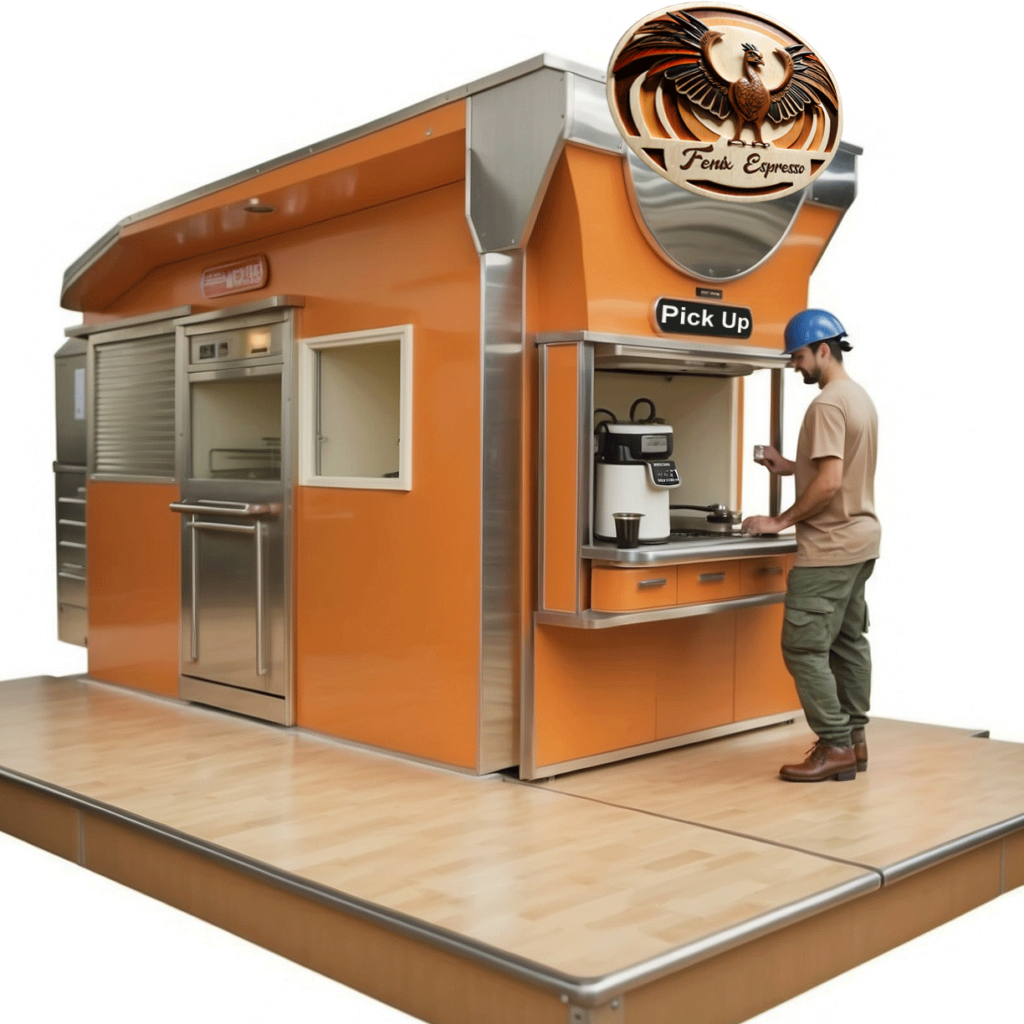300 Stands
Executive Summary:
Fenix Espresso aims to disrupt the coffee industry by directly competing with Starbucks through a
unique, socially responsible, and innovative approach. By focusing on empowerment, worker rights,
sustainability, and community engagement, Fenix Espresso will differentiate itself from Starbucks and
capture market share in targeted locations.

Key Strategies:
1. Establish popup stands (12′ x 8′ x 10′) – (15′ x 8′ x 10′) near vulnerable Starbucks cafes to compete
directly.
2. Implement a cooperative structure, offering equity stakes to coffee bean farmers, employees, and
stakeholders.
3. Ensure fair wages and benefits for all team members, with options to form or join worker
cooperatives or unions.


4. Partner with a local Seattle roaster known for high-quality, great-tasting coffee.( Caffe Vita)
5. Attract Starbucks baristas to work in Fenix Espresso stands by offering better working conditions
and ownership opportunities
6. Use “Open Ledger Fabric” in creating blockchain technology for transparency, efficiency, and a
visionary crypto payment system.
7. Align with B Corp principles and partner with sustainability experts to set a new standard in ecofriendly, ethical coffee production.
8. Build strong community connections through loyalty programs and customer engagement initiatives
9. Target over 300 university and college campuses across the US, replacing existing cafes with Fenix
Espresso stands
10. Employ students as part of a workers’ cooperative, giving them ownership in the company.


11. Digital Platforms for Communication: Use existing digital platforms or create a dedicated digital platform for stakeholders to communicate, share information, and manage aspects of the cooperative ownership structure.
11. Customer Engagement: Educate consumers on the impact of their purchases and the principles behind the cooperative ownership structure. Use marketing tools to link product choice with ethical impact.
12. Expansion Contingency Plans: Design the system with future blockchain integration in mind, ensuring that current processes can adapt to and integrate with blockchain technology as it becomes available and financially viable.
Rough Financials
STAND ONE
Total Initial Investment: $120,000
The detailed cost breakdown leading to this total is assumed to be factored in the initial summation.
•Annual Profit:
•Profit is calculated as 15% of the projected annual revenue.
•$200,000 (Revenue) * 15% (Profit Margin) = $30,000.
•Break-Even Point:
•The break-even point is calculated by dividing the total initial investment by the
annual profit.
•$120,000 (Initial Investment) / $30,000 (Annual Profit) = 4 years or 48 months.
•Return on Investment (ROI) Over 5 Years:
•The ROI is calculated by considering the total profit over 5 years in relation to
the initial investment.
•$30,000 (Annual Profit) * 5 (Years) = $150,000 (Total Profit over 5 Years).
•($150,000 (Total Profit) / $120,000 (Initial Investment)) * 100 = 125% ROI over
5 years.
•This means a total return of 125% relative to the initial investment over a period
of 5 years, indicating a substantial growth from the initial outlay.
300 Expansion
Milestones:
– Q1: Secure funding, finalize partnerships, and establish the first 10 popup stands
– Q2: Open an additional 20 stands and launch the “Open Ledger Fabric” blockchain system
– Q3: Expand to 50 total stands and begin targeting university and college campuses
– Q4: Reach 100 stands, including 20 on university and college campuses
– Year 2: Expand to 200 stands, with 50 on university and college campuses
– Year 3: Operate 300 stands, with 100 on university and college campuses, and achieve profitability
By investing in Fenix Espresso, you have the opportunity to be part of a revolutionary company that
prioritizes social responsibility, sustainability, and innovation while disrupting the coffee industry
dominated by Starbucks. Our unique approach, focused on empowerment and collective growth,
positions us for success in capturing market share and generating strong returns for our investors
300 Stand Expansion finances
To project the profit and Return on Investment (ROI) for Fenix Espresso based on the
expansion plan and using the initial per-stand investment of $120,000 with an
annual per-stand revenue of $200,000 and a profit margin of 15%, let’s break down the
profitability and ROI, year by year, based on the targeted number of stands.
Assumptions:
1.Each stand generates $200,000 in annual revenue.
2.The profit margin remains constant at 15%.
3.The expansion and operational costs of the “Open Ledger Fabric” blockchain system,
increased marketing efforts, and any variations in operational costs for stands on
university and college campuses are not included in this calculation for simplicity.
Year 1 Projections:
•Stands by Year End: 100
•Annual Revenue Per Stand: $200,000
•Total Revenue for Year 1: 100 stands * $200,000 = $20,000,000
•Profit Margin: 15%
•Total Profit for Year 1: $20,000,000 * 15% = $3,000,000
Year 2 Projections:
•Stands by Year End: 200
•Total Revenue for Year 2: 200 stands * $200,000 = $40,000,000
•Total Profit for Year 2: $40,000,000 * 15% = $6,000,000
Year 3 Projections:
•Stands by Year End: 300
•Total Revenue for Year 3: 300 stands * $200,000 = $60,000,000
•Total Profit for Year 3: $60,000,000 * 15% = $9,000,000
Cumulative 3-Year Projections:
•Total Revenue (Years 1-3): $20,000,000 + $40,000,000 + $60,000,000 =
$120,000,000
•Total Profit (Years 1-3): $3,000,000 + $6,000,000 + $9,000,000 = $18,000,000
ROI Calculation for 3 Years:
•Total Initial Investment for 3 Years: $37,200,000
•Total Profit for 3 Years: $18,000,000
•ROI: ($18,000,000 / $37,200,000) * 100 = 48.39%
Conclusion:
The Fenix Espresso expansion plan, over a period of 3 years, culminating in the operation of
300 stands, is projected to generate a total profit of $18,000,000. This leads to a ROI of
48.39% over the 3 years, factoring only direct stand operational profit and initial setup costs.
It’s important to consider that the calculated ROI does not account for additional operational,
marketing, and development costs which will likely affect the final figures. To achieve
profitability by Year 3 as proposed, operational efficiency, cost control, and effective revenue
generation strategies will be crucial.
© 2022 All Rights Reserved.

